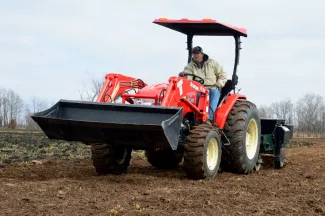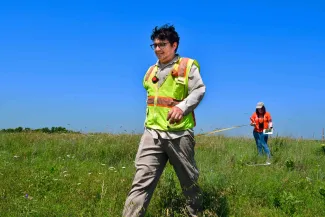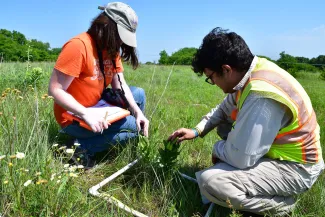
Colin Berg has a wildlife-driven vision for his Osage County property. In addition to improving habitat for deer, turkey and quail, Berg planted a three-acre plot to native wildflower seeds in 2018 to create monarch habitat and benefit pollinators.
Colin Berg has spent the past 28 years with the Wildlife Department sharing his passion for hunting and fishing. In addition to teaching a variety of outdoor skills, Berg also shares the importance and value of quality wildlife habitat to Oklahomans of all ages. And when he purchased private property in Osage County in 2011, he started putting those teachings into practice.
“It’s a lot of hard work, but it’s been really rewarding to see the results of all the habitat management practices from the last ten years,” said Berg.
Through partnerships with the Wildlife Department, U.S. Fish and Wildlife Service, and Natural Resources Conservation Service available to private landowners, Berg has been able to put his wildlife-driven plans for the property in action.
“I’ve been able to put in fencing to help with grazing rotations, build firebreaks, and conduct small prescribed burns through the available cost-share programs,” Berg said. “I even planted a couple of acres to a native wildflower seed mix with the help of a special monarch habitat project that started a few years ago.”
After five years of lending a helping hand to monarchs through the NRCS’s Monarch Butterfly Habitat Development Project, Berg and five other enrolled landowners are now lending a hand to scientists researching monarchs and their habitats.
“I’ve been putting in all of these different practices – I've burned, changed the grazing routine, and planted a native seed mix. I want to know if it’s working. And I want to know which practices I should keep doing to make the most impact for monarchs and other pollinators.”
To answer those questions, the NRCS has partnered with Oklahoma State University to monitor the project’s conservation outcomes.
Researchers Emily Geest and David Berman, both Ph.D. candidates in OSU’s Department of Integrative Biology, have recently been tasked with conducting milkweed and blooming plant surveys on each of the study’s cooperating properties.
“We’re looking at how different management practices affect the growth and density of milkweed and other flowering plants,” said Geest. “We’ll be documenting how many milkweed stems are growing here, if they’re vegetative, flowering, or in the seed pod stage, and what other plants are blooming within our transects.”
The pair stretches a tape measure up to 100 meters from a series of randomly chosen points located across the properties, and then uses a 1-meter-square quadrat made from plastic PVC to assess the plant community on each side of the tape measure every five meters along the transect.

David Berman and Emily Geest stretch a measuring tape to gauge the density of milkweeds and other blooming plants in their monarch habitat study area.

Geest and Berman use national protocols to document the number of stems and the flowering stage of a green milkweed plant growing within their sample plot.
The monitoring portion of the project has only just begun after a pandemic-caused delay, but the research duo is excited by the diversity they’ve already encountered.
“I really enjoy looking across a grassland and seeing the diversity in plant communities and landscapes. But when we start looking at a fine scale – within one square meter of that grassland – we get to see so many different species of plants and insects living their life,” said Berman.
“We’ve already spotted four different species of milkweed on this property in just a few hours and a handful of transects,” Geest said. “I think the diversity of plants and butterflies we’ve seen today is a great start in showing that landowner’s management actions and choices can make a positive difference for pollinators and other wildlife.”
Learn more about the conservation programs in your area by reaching out to the Wildlife Department’s private lands program.